Code History Summary¶
Internal Links¶
Links are provided of the following types:
ADDITIONAL INFORMATION and BLUE LINKS WITHIN TEXT: Links are provided to alert the reader to supplemental information or stories pertinent to the present discussion.
PHOTO: These links connect you to pictures or photos of significance to the discussion.
SOURCE: References are provided to credit the sources of the information provided in the text which follows, the text may not include the entirety of the original source discussion.
In each case clicking on the link will connect you to the information.
Selecting the upper left return arrow will return you to previous pages.

Introduction¶
The Code family had a long history of residency in Ireland. During that period frequent wars and rebellions had resulted in the loss of many church records, thus, hindering the tracing of direct Irish ancestry prior to the 1700s. The Code surname (Cod, Codd, Codde, Coad and Kodde), however, has its own history dating to much earlier times. Various sources indicate that the surname first appeared in England as a result of William the Conqueror's Norman invasion in 1066 A.D. A century later the surname is said to have first appeared in Ireland as a result of Strongbow's Norman invasion in 1170 A.D. The following are a few examples of the internet sites that affirm the Code family connection with the Norman movement:
FAMILY TREE DNA HOME (Codd/Code/Coad Family)
We are hoping to discover connections between Codd families in Ireland, England, Wales and the various locations their descendants emigrated to. The general historical outline that we have for the Codd family is that they were part of the Norman contingent that arrived in England in 1066 with William the Conqueror, dwelt in Cornwall and Devon and then some Codd's moved to Pembroke in Wales and from there continued with the Norman expansion into Ireland in 1172 with Richard Strongbow, one branch finally settling in Ferns diosesce, Ir (which became Wicklow, Wexford etc.). We would like to try to trace this migration through DNA testing of Codd ancestors and to discover where they were from prior to the Norman invasion of 1066.
FAMILY TIES PART 13: THE CODD FAMILY (Keith Evans)
The general opinion seems to be that the name Codd came over with the Normans at the time of William the Conqueror and spread out from England when the Norman earls and knights settled and intermarried in Pembroke shire with the daughters of Welsh nobility from different parts of Wales and the Norman soldiers married local Pembroke shire girls. As to their origins before the Norman Conquest, that remains a mystery yet to be solved.
In search of my McCreary-Magee-McGee Codd/Code Ancestors in Lanark County, Ontario, Canada (Brian Bailey)
The Codd (or Code) family came to Wicklow County from the "Barony of Forth" County Wexford (17th century). Their origin was English - and ultimately Anglo-Norman - coming over from Normandy with William the Conqueror, and arriving in Ireland at Castletown in Wexford with Strongbow in 1190 as landed gentry.
The following historical overview is based on the assumed parallel histories of the migrations of the Code family and the expansion of Norman culture. Speculations about earlier origins involve a discussion of the genesis of the area of France that became known as Normandy.
Keep in mind that the date ranges for ancestral Code family residency for each of the following countries (areas) are based on historic cultural transitions and personal speculation. The first well documented instance of residency is that of Thomas Codd and his family in Wicklow, Ireland from his birth in 1773 until immigration to Canada in 1820.
Video Resources - Normans¶
For anyone interested in forming a greater historical perspective, the following links to a PBS series about the Normans are recommended. Sections one and two cover the periods and locations in which Code (Codd) ancestors are assumed to have resided. The third is also quite interesting but centers on the Norman efforts in Italy, Sicily and the Middle East. Each is about an hour long. The Normans were consummate warriors in a time when warriors appear to have dominated history. They were also mariners, farmers, traders, fisherman and builders with a strong sense of community and ethnic identity.
Note: Two sites per episode are provided in the event that there are issues with access. The same episode is available at two different sites.
The Normans 1 - Men from the North (2010)
The Normans 2 - Conquest (2010)
The Normans 3 - Normans of the South (2010)
Code Family European Pathway
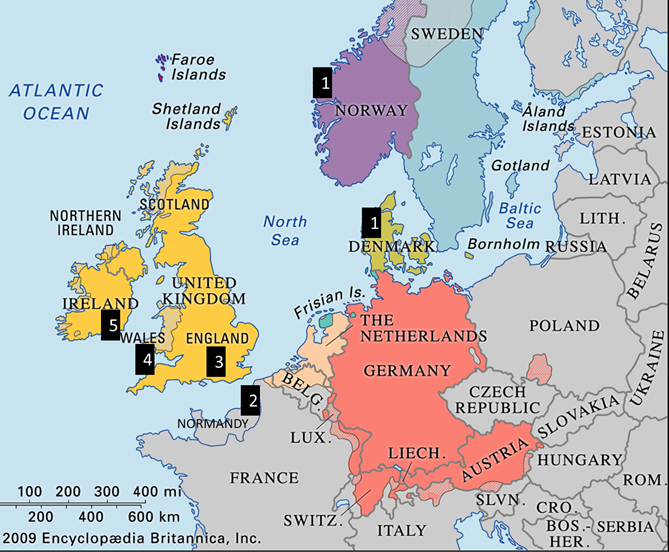
-
Scandinavia, Norway or Denmark ( -900)
-
France, Normandy (900-1066)
-
England (1066-1100)
-
Wales, Pembroke-shire (1100-1170)
-
Ireland, Wexford and Wicklow Counties (1170-1820)
Scandinavia ( -900)¶
Viking Age
The beginning of the Viking Age in the British Isles is often set at 793. It was recorded in the Anglo-Saxon Chronicle that the Northmen raided the important island monastery of Lindisfarne.
This year came dreadful forewarnings over the land of the Northumbrians, terrifying the people most woefully: these were immense sheets of light rushing through the air, and whirlwinds, and fiery dragons flying across the firmament. These tremendous tokens were soon followed by a great famine: and not long after, on the sixth day before the ides of January in the same year, the harrowing inroads of heathen men made lamentable havoc in the church of God in Holy-island (Lindisfarne), by rapine and slaughter.
- Anglo Saxon Chronicle
In 794, according to the Annals of Ulster, a serious attack was made on Lindisfarne's mother-house of Iona, which was followed in 795 by raids upon the northern coast of Ireland. From bases there, the Norsemen attacked Iona again in 802, causing great slaughter amongst the Céli Dé Brethren, and burning the abbey to the ground.

Viking expeditions (blue line): depicting the immense breadth of their voyages through most of Europe, the Mediterranean Sea, Northern Africa, Asia Minor, the Arctic, and North America.
The Kingdom of the Franks under Charlemagne was particularly devastated by these raiders, who could sail up the Seine with near impunity. Near the end of Charlemagne's reign (and throughout the reigns of his sons and grandsons), a string of Norse raids began, culminating in a gradual Scandinavian conquest and settlement of the region now known as Normandy.
The longships used by the Scandinavians were uniquely suited to both deep and shallow waters. They extended the reach of Norse raiders, traders, and settlers along coastlines and along the major river valleys of north-western Europe.
France (900-1066)¶
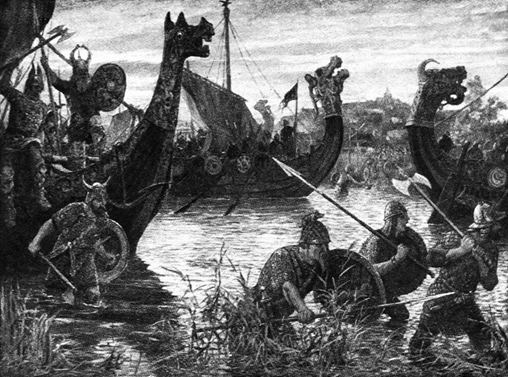
Vikings and the Siege of Paris - Origins of Normandy
Prior to 900 A.D. France (Paris in particular) was experiencing repeated invasions by various bands of Vikings. After significant loss of life as well as precious jewels, gold and silver, the French were able to enter into an agreement with Rollo, one of the most prominent of the invading Viking leaders.
ADDITIONAL INFORMATION: Three Rollo Statues (Alesund, Norway, Rouen, France and Fargo, North Dakota)
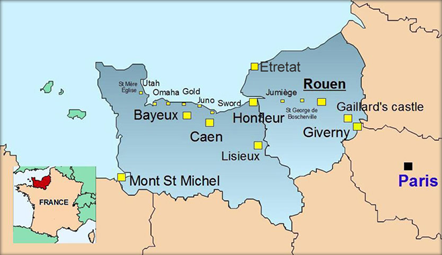
The arrangement provided the area that became known as Normandy (the name Normandy refers to men from the North) in exchange for certain conditions. The agreement stipulated that Rollo's Vikings would thereafter protect Paris from other Viking invasions, he and his men would convert to Christianity and that Rollo would marry one of the King's daughters. The strong affiliation that appears to have existed between our Code ancestors and the Norman movement may also indicate earlier Viking origins most likely from Denmark or western Norway in the area of Møre og Romsdal. In addition to being fierce and accomplished warriors, these Vikings, now Normans, were farmers, fishermen and very skillful in the construction of boats and all types of buildings.
The land in Normandy was a huge improvement on the old farmlands in Norway. The Norman focus was on the cultivation of grain and the rich, heavy soil of Normandy could yield four times more than the stony soil of Norway.
Over the next one hundred and fifty years, the Normans settled in with their new neighbors. They strategically intermarried, made alliances and copied the French hierarchy headed by a class of nobility.
But one aspect of Viking ancestry that the Normans were slow to lose was a restless ambition. A desire to expand beyond current boundaries and gather more material possessions, land, power and glory. The Normans could back up their individual ambition with the power of feudalism, farming, fighting technology, their religious perspective and their strategic use of the castle.
From 1047 to 1200 this Norman ambition and capability would trigger one of the most extraordinary expansions of power from such a small area. Leadership of Normandy passed through a succession of Rollo's descendants. In 1035, Duke Robert of Normandy was killed on the return from one of the first crusades and his son, William gradually assumed his power and title. In 1066, the King of England at the time – Edward the Confessor died and the throne was claimed by Harold Godwinson.
England (1066-1170)¶

The Landing of William the Conqueror at Hastings by Charles Edward Dixon 1910 (sourced from Christies.com)
William of Normandy believed he was entitled to become the King of England following the death of King Edward. Neither the rationale for his sense of entitlement nor the details of William's invasion of England will be discussed here. Following, however, is a very brief timetable of the invasion:
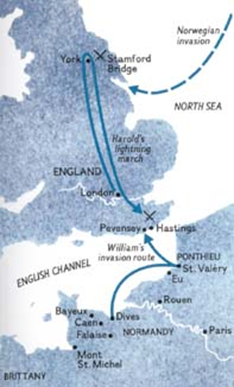
- Early September 1066: Harold Hardraada (King of Norway who sought to claim the English throne), supported by Tostig (exiled brother of Harold Godwineson), invaded northern England.
- September 25: Battle of Stamford Bridge. Harold Godwineson (newly crowned Anglo-Saxon King of England) defeated Harold Hardraada and Tostig.
- September 28: Duke William landed at Pevensey.
- October 6: Harold Godwineson returned to London.
- October 14: Battle of Hastings. William defeated and killed Harold Godwineson.
Following William the Conqueror's successful conquest of England, members of the Code (Codd) family surfaced in England. Some were listed among the knights who built castles in England. The Normans were prolific in the building of castles and cathedrals during the time that they ruled England and elsewhere.
Establishing Control
In occupied England, the Normans needed to develop means of controlling the native population since they were vastly outnumbered. William's military leaders were granted lands and titles in return for their support in the invasion. William claimed ultimate possession of all lands England and he asserted the right to dispose of it as he saw fit. All land was "held" directly from the king in feudal tenure in return for military service. A Norman lord’s properties may be scattered throughout England and Normandy, and not in a single geographic block.
William confiscated the estates of all the English lords who had fought and died with Harold and redistributed part of their lands to his followers. These confiscations led to revolts, which resulted in more confiscations, a cycle that continued for five years after the Battle of Hastings. To put down and prevent further rebellions the Normans constructed castles and fortifications in unprecedented numbers. In order to exercise tighter control over the inheritance of properties by widows and daughters, William and his barons often demanded marriages to Normans where properties were involved.
An estimated 8000 Normans and other continentals settled in England as a result of the conquest. Some of these new residents intermarried with the native English, but such marriages were uncommon. Most Normans continued to contract marriages with other Normans or other continental families rather than with the English. Within a century of the invasion, intermarriage between the native English and the Norman immigrants had become common in all levels of society.
For the decade following the conquest there was a gradual expansion of French-Norman authority throughout England. These were turbulent times when William the Conqueror had to consolidate his position against a background of Saxon rebellion and Scandinavian claims to his newly acquired throne. He had resolved to dispossess most of the native landholders and redistribute their estates among those loyalists who had supported his efforts.
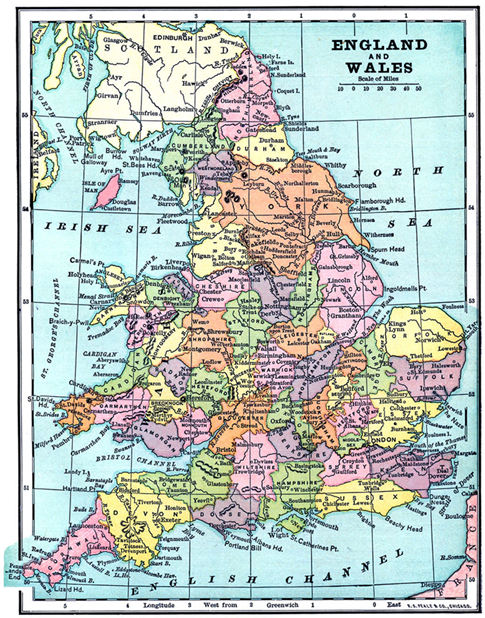
Devon and Cornwall (1068 - 1170)¶
By 1068 large areas of the country, including the south-west, still stood beyond the limits of French-Norman authority. That year a rebellion broke out in Exeter serious enough to warrant a royal expedition when the Conqueror himself is said to have marched into Devon and Cornwall. As a result, most of Cornwall was granted to a Count Brian of Brittany. He had fought at Hastings and took part in the 1068 campaign, but subsequently forfeited his lands after he took part in a baronial rebellion against the King in 1075. Soon after his lands in Cornwall and Devon were bestowed on Robert, Count of Mortain.
A few years before the Conquest he had been entrusted with the French-Norman feudal estate of Mortain and he is supposed to have contributed as many as 120 ships to William’s invasion force. He fought at Hastings, and the famous Bayeux Tapestry depicts him as seated on the Conqueror’s left with his sword half-drawn. Robert’s support was generously rewarded, and by 1086 he held over a thousand English manors. Many of his estates were concentrated in the south-west and in Cornwall his position was clearly exceptional. Count Robert of Mortain died in or about 1090 when his lands in Cornwall and elsewhere passed to his son, William. In 1106, however, William was dispossessed for his part in a baronial rebellion against Henry I. New arrangements had to be made with his sub-tenants, and in Cornwall many were elevated to the position of tenants-in-chief, holding their lands directly from the Crown.
The society and economy of late 11th-century Cornwall was divided into several administrative districts known as hundreds, which were in turn controlled from a prominent estate. The farms, villages and hamlets within each hundred were then grouped into manors. In many parts of the country the manor was a recognizable unit, but in Cornwall’s case it is best seen as a term of administrative convenience which absorbed a diversity of settlements.
Cornwall was a land of relative poverty. The population of Cornwall at the time was around 27,000 with over twenty per cent, classified as serfs or slaves. Few tears are likely to have been shed by the ordinary people of Cornwall over the dispossession of the prior Saxons/English, but at the same time one ruling class had simply been replaced by another. The new landholders probably lived elsewhere, making only occasional visits to their estates. The French-Norman presence in Cornwall consisted of a few hundred administrators, castle-wardens, monks and merchants.
Following William, the Conqueror’s invasion of England in 1066, Code ancestors had migrated to Devon and Cornwall sometime during this period. Notably Osbert Codd (a possible ancestor) was born in Devonshire and his father was said to be from Cornwall. Osbert migrated to Pembroke in Wales and was the first of the Codds to settle in Wexford County, Ireland following the Norman invasion in 1170. A century and at least three generations of our Codds ancestors would pass during their residency in England.
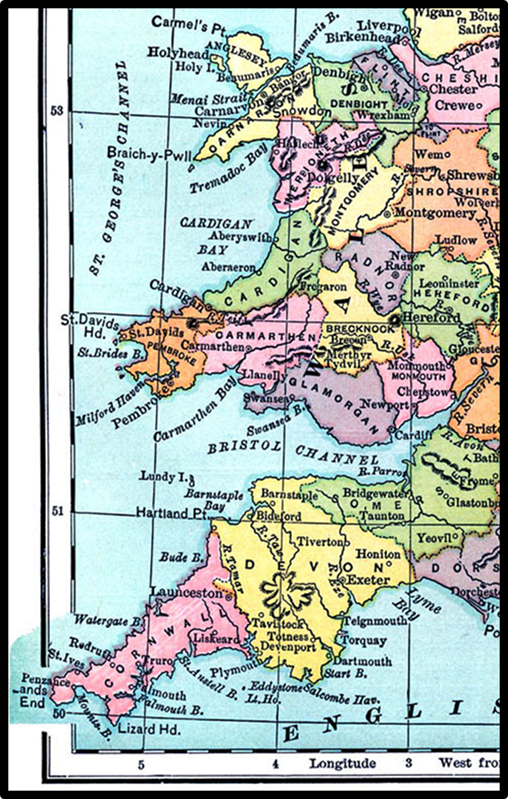
Cornwall and Devon across the Bristol Channel from Pemproke and Carmarthen
Wales (1100 – 1170)¶
It appears that after initial residences in southwestern England (Devon and Cornwall) our Code ancestors ventured into Wales where the decentralized ruling structure did not lend itself to easy conquest. In fact, for over 200 years Wales was the scene of civil war and insurrection – not an enviable place in which to live. By 1098, the Normans were secure enough to found Monkton Priory in Pembrokeshire. Pembroke was to become a Norman power-base and the surrounding area of South Pembroke shire gradually fell under their control. It appears that our Code ancestors eventually resided in the county of Pembrokeshire although the duration is unknown.

Ireland (1170-1819)¶
Video Resources - Ireland¶
The BBC Documentary The Story of Ireland (links below) is a very good resource for anyone who might have an interest in developing an understanding of what life may have been like during that period in Ireland. The second and third installments of the five-part series cover the time Code ancestors resided in Ireland. The first half of the second BBC episode covers the invasion (1169) of the Anglo-Normans (including the Codds) into Ireland. The last half of the third episode covers the 1798 Rebellion in Ireland in which much of the fighting occurred in region in and around Wexford County. These two events would be of most interest and relevance to the family history, though the rest is equally intriguing. Each of the BBC episodes is around an hour long and provide a better understanding regarding the forces that brought about transitions in Irish society and history.
Ireland - Age of Conquest
BBC The Story of Ireland 2 of 5 Age of Conquest
Ireland - Age of Revolution
BBC The Story of Ireland 3 of 5 Age of Revolution
Codd Irish History¶
Invasion by Anglo-Normans
Around 1170 Richard "Strongbow" de Clare was able to assemble an army of fellow Normans, the majority from Wales, for an invasion of Ireland. As a result of the successful invasion the County of Wexford became the new home for the now Irish Codd family. A 1247 list of Knight's fees includes the following names of the new 'owners': de Heddon (Hayden), Howel, de London, de Bosco, Chever (Cheevers), Brun (Browne), Ketting (Keating), Purcell, de Wythay (Whitty), Cod (Codd), de Prendelgast (Prendergast), and de Rupe (Roche). The Codd family initially settled in Wexford County – later moving north to neighboring Wicklow County.
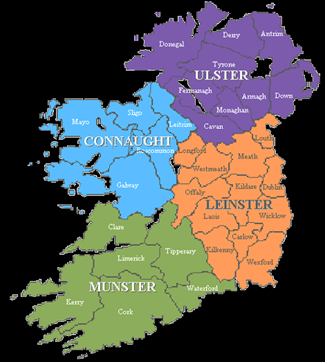
Following the Norman invasions of 1169 and 1171, Ireland was under alternating levels of control from Norman lords and the King of England. Throughout this period there were many rebellions against British and Norman rule (notably in 1315, 1579, 1594, 1641, 1642, 1690, 1740, 1798 and 1803). The following are a few of many significant events that affected life in Wexford and neighboring Wicklow counties during the time Code ancestors resided there.
The Black Death (bubonic plague) ravaged Ireland 1348-49. One observer wrote "It was rare for only one member of a family to die, but that usually the entire family was wiped out".
The native Irish began to regain some of their former territories in the 14th century, especially in the north of the county.
Under Henry VIII the great religious houses were dissolved, 1536-41. All their lands and possessions were confiscated and became the King's property, who subsequently granted them to new owners including many in Wexford County
In 1641, a major Rebellion broke out in Ireland. In 1649, Oliver Cromwell and his English Parliamentarian Army first arrived in County Wexford to deal with the rebels located there. Wexford town was sacked by Cromwell and his Army, 11 October 1649 and hundreds of civilians were killed in the process. Oliver Cromwell was blamed for the massacre by the people of County Wexford and of Ireland in general. About 1655 the county was remapped under the Down Survey. The lands of the Irish and Anglo-Normans were confiscated and given to Cromwell's soldiers as payment for their service in the Parliamentarian Army.
Though there had been many earlier laws enacted against Catholics in Ireland, the year 1695 marked the real beginning of what were called the Penal Laws. These laws primarily discriminated against Catholics and did not begin to be relaxed until the end of the 18th century.
A famine around 1740 was responsible for the loss of 13% to 20% of the Irish population.
County Wexford saw the heaviest fighting of the 1798 Rebellion, with significant battles at Enniscorthy and New Ross. Irish and British forces traded victories over the following months. On 9 June 1798, Wexford Rebels, joined by rebels from County Wicklow, were defeated at the Battle of Arklow, County Wicklow. At this stage, Government and Loyalist troops were now closing in on the Rebels from all sides. The Rebels were defeated at the Battle of Vinegar Hill, 21 June 1798. That was the last major action in County Wexford. The rebels (mostly native Catholic Irish) were severely punished for their participation.
Early Codd families¶
The following information outlines the families of presumed ancestors of Thomas Codd. Additional verification for these ancestors may be needed. The source indicates that James George Codd was born in Wexford County, Ireland and died in Wicklow County signaling a possible time of transition in location for the family:
Abraham Codd (1680- ) married Margaret Doye (1683-1726).
Children:
James George Codd (1698-1763) married Ann Groves (1711-1760).
........................................
James George Codd (1698-1763) married (c. 1732) Ann Groves (1711-1760).
Children:
George Codd (1732- ) married (c. 1764) Rachel Twamley (1737-1826 ).
Elizabeth "Eliza" Codd (1733-1756)
Abraham (1737- )
James (1741- )
Jane (1743- )
Ann (1745- )
John (1747- )
Thomas (1751- )
Frances (1756- )
........................................
George Codd (1732- ) married (c. 1764) Rachel Twamley (1737-1826).
Children:
Rachel Jane Codd (1765-1835) married William Dack.
George Codd (1767-1835)
Captain John Codd (1769-1827) married (c. 1786) Ann Groves (1767- ).
Abraham Codd (1770- )
Alexander Codd (1771- )
Thomas Codd (1773-1852) married (c. 1800) Lady Elizabeth Twamley (1774-1839).
........................................
Thomas Codd (1773-1852)¶
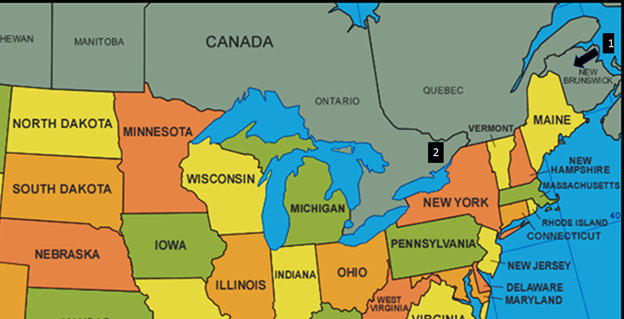
-
Ireland, Wicklow County (1773-1819)
-
Canada, Lanark County, Ontario (1819-1852)
Thomas (Codd) Coad, son of George Codd and Rachel Twamley, was born in 1773 in Aghowle Parish, Munahullin Townland, Shillelagh Baronry, Wicklow County, Ireland and died on 23 Jul 1852 in Lanark Twp, Lanark County, Ontario, Canada at age 79.
Thomas married Lady Elizabeth Twamley in 1800 in Wicklow County, Ireland. Elizabeth was born in 1774 in Cronelea, Mullancuff Parish, Shillelagh Baronry, Wicklow, Ireland and died on 20 Oct 1839 in Lanark County, Ontario, Canada at age 61. They had 7 children. Lady Elizabeth Twamley and Family
Children from this marriage were:
George Code was born in Dec 1800 in Cronelea, Mullancuff Parish, Shillelagh Baronry, Wicklow, Ireland and died on 20 Mar 1887 in Elma Twp, Perth County, Ontario, Canada at age 86.
George married Sarah Boyd, daughter of John Boyd and Margaret Campbell, on 20 Feb 1824 in Perth, Lanark County, Ontario, Canada. Sarah was born in 1803 in Koady, Armagh, Ireland, died on 29 May 1865 in Elma Twp, Perth County, Ontario, Canada at age 62, and was buried in Elma Center Cemetery, Perth, Ontario, Canada. They had 9 children.
Rachel Code was born on 15 Sep 1805 in Cronelea, Mullancuff Parish, Shillelagh Baronry, Wicklow, Ireland, died on 15 Nov 1887 in Lanark Twp, Lanark County, Ontario, Canada at age 82, and was buried in Boyd's Methodist Cemetery, Lanark County, Ontario, Canada.
Rachel married Thomas Jackson, son of John Jackson and Sarah Esther Kersey, on 1 Jan 1821 in St. James, Perth County, Ontario, Canada. Thomas was born in 1798 in Tullow County, Carlow, Ireland, died on 13 Aug 1881 in Lanark Twp, Lanark County, Ontario, Canada at age 83, and was buried in Boyd's Methodist Cemetery, Lanark County, Ontario, Canada. They had 7 children.
Thomas Code was born in 1807 in Cronelea, Mullancuff Parish, Shillelagh Baronry, Wicklow, Ireland and died on 29 Jan 1897 in Lanark County, Ontario, Canada at age 90.
Thomas married Mary Jane James, daughter of William James and Elizabeth Chamney, on 7 Sep 1830 in Lanark County, Ontario, Canada. Mary was born on 7 Apr 1813 in Munahullan, Aghowle Parish, Wicklow County, Ireland and died on 20 Mar 1844 in East Wawanosh, Huron County, Ontario, Canada at age 30. They had 6 children.
Thomas next married Mary Price on 7 Sep 1845 in Lanark County, Ontario, Canada. Mary was born on 8 Sep 1821 in Wicklow County, Ireland and died on 21 Aug 1904 in Lanark County, Ontario, Canada at age 82. They had 10 children.
Letitia Code was born in 1809 in Knockalane (Kilkenny), Ireland and died on 18 Aug 1886 in Stanton, Goodhue County, Minnesota at age 77. Notes for Letitia Code
Letitia married Edward Dack, son of William Dack and Jane Code, in 1828 in Johnstown, Ontario, Canada. Edward was born on 6 Mar 1806 in Kitley Twp, Leeds County, Ontario, Canada and died on 20 Apr 1880 in Stanton, Goodhue County, Minnesota at age 74. They had 12 children.
Richard Coad was born on 13 Oct 1812 in Aghold Church, Wicklow County, Ireland and died on 15 Aug 1887 in Wawanosh Twp, Huron County, Ontario, Canada at age 74.
Richard married Mary James, daughter of Thomas James and Elizabeth Groves, on 4 May 1841 in St. James, Lanark Twp, Lanark County, Ontario, Canada. Mary was born on 24 Oct 1815 in Cronelea, Mullancuff Parish, Shillelagh Baronry, Wicklow, Ireland and died on 25 Mar 1884 in Wawanosh Twp, Huron County, Ontario, Canada at age 68. They had 7 children.
Abraham Code, was born in Jan 1815 in Cronelea, Wicklow, Ireland, died on 10 Feb 1897 in Park River, North Dakota at age 82, and was buried in Park River Memorial Park, Park River, North Dakota.
Abraham married Lettitia James, daughter of William James and Elizabeth Chamney, on 28 Jun 1839 in Bathhurst District, Lanark County, Ontario, Canada. Lettitia was born on 10 Mar 1816 in Aghowle Parish, Munahullan Townland, Wicklow, Ireland, died on 24 Jul 1884 in Park River, Dakota Territory, USA at age 68, and was buried in Park River Memorial Park, Park River, North Dakota. They had 7 children.
James Codd was born on 15 Jun 1821 in Lanark County, Ontario, Canada and died in 1870 in Saginaw, Michigan at age 49.
James married Elizabeth Stevenson, daughter of Andrew Stevenson and Mary Boyd, on 18 Feb 1846 in Lanark Twp, Lanark County, Ontario, Canada. Elizabeth was born in 1824 in Lanark Twp, Lanark County, Ontario, Canada and died on 30 Nov 1877 in Saginaw, Michigan at age 53. They had 7 children.
Thomas Codd was born and raised in Shillelagh Baronry, Wicklow County, Ireland in a protestant (Church of Ireland) family of nine children (five sons and four daughters). The Codd family once had landed gentry status dating back to the time of Stongbow's invasion in 1170. That had been lost more than a century prior to Thomas' birth, possibly as a result of Oliver Cromwell’s rampage through Wexford around 1650. Cromwell and his army landed in Ireland and brutally crushed the Irish Catholic Confederation – an alliance of Irish Catholic nobles, clergy members and military leaders that had been in control of Ireland for a number of years. This alliance was considered to be a military threat to the newly established parliament of England. Cromwell’s soldiers were rewarded with land held by native and Norman Irish and may have precipitated the Codd family migration north from Wexford to Wicklow County.
The family of Thomas Codd resided in Wicklow County, Shillelagh Baronry, Aghowle Parish.
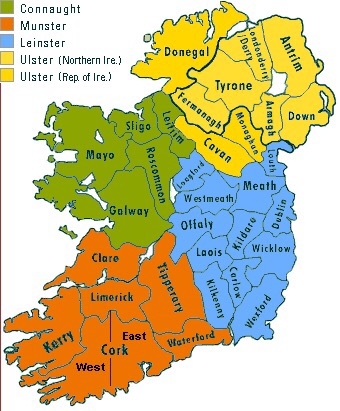
Wexford and Wicklow in blue coastal region (From Wikimedia Commons)
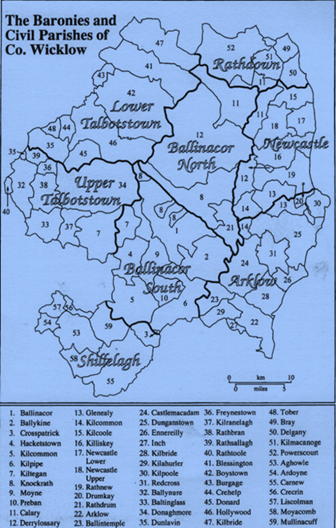
Wicklow County, Shillelagh Baronry, Aghowle Parish. (Area #53 on map). Map from: Site Wicklow Heritage
Thomas came to maturity during turbulent times in Wexford and Wicklow Counties. Unpopular laws and taxes enacted by the British had precipitated protest and defiance among the native Irish Catholics over several decades. During the 1798 Irish Rebellion Wexford and Wicklow Counties were involved in some of the heaviest fighting.
Wicklow in the 1790's had a higher percentage of Protestants than any other Irish county excluding Ulster. The rebellion in Wicklow was most violent. Houses all over the county were set on fire, people were killed on suspicion of being either rebels or Orangemen. The members of the United Irishmen were both Catholic and Protestants. At its conclusion the British prevailed and the rebels, who were mostly native Irish Catholic, were severely punished. One of the deciding battles was at Vinegar Hill near Enniscorthy in Wexford County.

Defeat at Vinegar Hill - illustrated by George Cruikshank (1845)
The animosity between local Catholic and Protestant Irish residents, however, continued long after the British victory. A member of the Twamley family was piked to death in Wicklow in the aftermath of the Rebellion as tensions continued. There is limited information regarding the role the mostly Protestant Codd families played during the 1798 Rebellion. One source implied that they had protected their property but had not actively participated as rebel sympathizers or British loyalists. They did of course have religious (Anglican) and historic (Norman) connections to British rule.
Around 1800, at age 27, Thomas Codd married Lady Elizabeth Twamley (age 21) who was also a life-long resident of Shillelagh Baronry. Elizabeth was said to be from a higher stratum of Irish Protestant society than Thomas. The couple were members of the Church of Ireland that embraced Methodism. The Codd and Twamley families had a long history together in Wicklow County including other instances of intermarriage. Elizabeth gave birth to George (1800), Rachel (1805), Thomas (1807), Lettitia (1809), Richard (1812) and Abraham (1815) in Wicklow County.
Continuing animosity between native Irish Catholics and Protestants following the Rebellion found many Anglican Irish becoming increasingly uncomfortable at home. This was true of the Twamley and Codd families as well as the Chamney, James and Dagg (or Dack) families with whom the Codd family had shared long histories in Wicklow County.
Meanwhile, in Canada, Great Britain's undermanned success in fending off the Americans in the War of 1812, signaled the need to develop loyal militias in case of future incursions from south of the border. The British had employed a strategy of bringing in settlers who could be expected to remain loyal to the British crown and to fight for it if required. Lanark County was a primeval forest covering land which was so rocky that it would prove to be largely unsuitable for farming. It was, however, available and it was being allotted, township by township to shiploads of Scottish and Irish emigrants. Several generations of the ancestors of Thomas and Elizabeth (Twamley) Codd had resided in Wexford and Wicklow Counties.
Now Thomas and Elizabeth, with their six children (ages 3 to 19 years), sailed from Ireland in 1819 to Canada. The voyage appeared to have included several of their Wicklow friends and acquaintances, including the James family with Letitia James who would become the wife of Abraham Code. Letitia's sister, Mary, was also to wed Abraham's brother Richard. At the time Thomas Codd was 46 years old and Elizabeth Twamley 41. The ages of the children were George 19, Rachel 14, Thomas 11, Letitia 10, and Richard 7. The youngest, Abraham Code, born in Wicklow County, Ireland in 1815 and would have been around four years old when the family immigrated and his future spouse, Lettitia James, would have been three years old.
As new settlers arrived, largely after an eight-week passage on a less-than-hospitable sailing ship landing at Quebec City, they boarded a steamship which brought them up the St. Lawrence River to Elizabethtown (now Brockville). There, they embarked on a journey, on foot, northward to discover where in the forest they would be assigned a place. Plots of 100 acres were assigned for each male who had reached the age of 18. They were given the rudiments of building a home and setting up a workable farm with the grant becoming permanent if they cleared a certain portion of the land within the first four years.
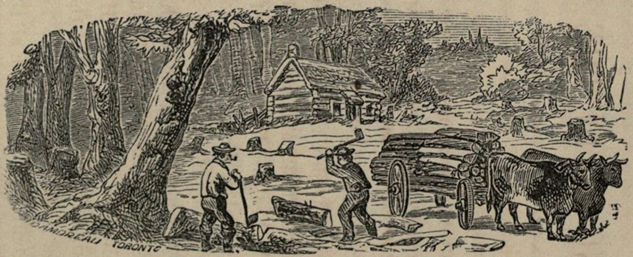
From: Roughing it in the Bush; or, Forest Life in Canada, Author: Moodie, Susanna (1803-1885) Illustrator: Damoreau, Charles F. (fl. ca. 1856-1871)
Shelters needed to be built suitable to weather the cold and snow of the Ontario winter. Provisions needed to be set aside, and wood gathered to supply warmth for the winter. Extensive clearing would be necessary to prepare the marginal soil for planting. Most houses were log-built and simple and at the time there were few roads, so traffic from place to place was largely on foot. There were many hardships and few resources. The family was fortunate to have children old enough to share in the workload. The soil was very rocky, not at all like the lush farmlands of Wicklow, Wexford and Carlow, an anomaly which led to the next generation tending to move further west in Ontario. The removal of stones fell often to the younger generation. A seventh child, James, was born in 1821 to Thomas and Elizabeth Codd.
The elder Thomas and his son Richard changed the spelling of their surname from Codd to Coad and the remainder of the family revised the spelling to Code. Over time the children married and followed their own paths. Geroge married Sarah Boyd and moved westward to Perth County in Ontario where they had nine children. Rachel remained in Lanark county following her marriage to Thomas Jackson and had seven children. Thomas Code married Mary Jane James and moved west to Huron County where Mary gave birth to six children before passing away at the age of 30. Thomas then married Mary Price and returned to Lanark County. They had ten children. Lettitia married Edward Dack and the couple moved to Minnesota where they had twelve children. Richard Coad married Mary James (from different parents than Mary Jane James). The couple moved to Huron County where they had seven children. Abraham Code married Lettitia James, sister of Mary Jane James. They had seven children in Lanark County. The couple eventually moved to North Dakota with several of their sons. The youngest, James Code, married Elizabeth Stevenson. The couple had seven children, most born in Ontario, before moving to Michigan where Thomas died in a lumbering accident at age 49.
Thomas and Elizabeth spent their remaining years on the farm. Elizabeth died in 1939. Thomas deeded some of his land (part of the SW ½ of lot 4, and the NE ½ of lot 5, concession 12, Lanark) to Abraham in 1844. Thomas died there in 1952.
ADDITIONAL INFORMATION: The following site contains additional history for the Codd family in Ireland and Canada from family historian Brian Baily: Code History
Abraham Code (1815-1897)¶
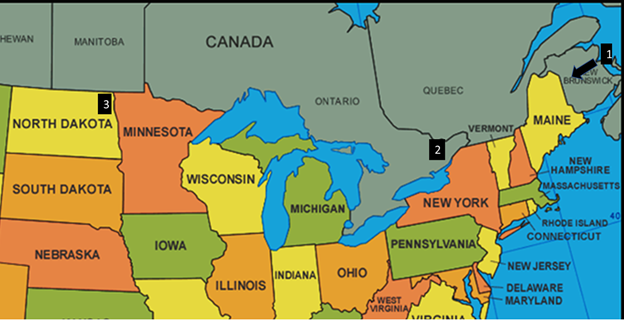
-
Ireland, Wicklow County (1815-1819)
-
Canada, Lanark County, Ontario (1819-1880)
-
North Dakota, Park River (1880-1897)
Abraham Code, son of Thomas Codd and Lady Elizabeth Twamley, was born in Jan 1815 in Cronelea, Wicklow, Ireland, died on 10 Feb 1897 in Park River, North Dakota at age 82, and was buried in Park River Memorial Park, Park River, North Dakota.
Abraham married Lettitia James on 28 Jun 1839 in Bathhurst District, Lanark County, Ontario, Canada. Lettitia was born on 10 Mar 1816 in Aghowle Parish, Munahullan Townland, Wicklow, Ireland, died on 24 Jul 1884 in Park River, Dakota Territory, USA at age 68, and was buried in Park River Memorial Park, Park River, North Dakota. They had 7 children. Family of Lettitia James
Children from this marriage were:
Thomas James Code was born on 24 Mar 1840 in Ontario, Canada, died on 11 May 1918 in Vancouver, British Columbia, Canada at age 78, and was buried in Mountain View Cemetery, Vancouver, Canada.
Thomas married Janet McEwen on 1 Jan 1864 in St. James Parish, Carelton Place, Lanark, Ontario, Canada. Janet was born in 1844 in Ontario, Canada and died on 22 Feb 1915 in Vancouver, British Columbia, Canada at age 71. They had 3 children.
Elizabeth (Ema) Code was born on 24 Oct 1841 in Innisville, Lanark, Ontario, Canada, died on 6 May1918 in Ramsey Twp, Lanark County, Ontario, Canada at age 76, and was buried in Clayton, Lanark County, Ontario, Canada. Elizabeth Code Foster Obituary
Elizabeth married Thomas Collins Foster, son of Thomas Foster and Jane Collins, on 4 Apr 1867 in Ramsey Twp, Lanark County, Ontario, Canada. Thomas was born on 26 Jan 1838 in Carleton Place, Ontario, Canada and died on 14 Jun 1905 in Ramsey Twp, Lanark County, Ontario, Canada at age 67. They had 6 children.
William H. Code was born on 13 Sep 1843 in Carleton Place, Lanark County, Ontario, Canada, died on 12 Oct 1931 in Mossbank, Saskatchewan, Canada at age 88, and was buried in 1931 in Saskatchewan, Canada. William Code's Half-Way-House
William married Margaret Ennis, daughter of James Ennis and Caroline Buell, on 18 Jan 1869 in Innisville, Ontario, Canada. Margaret was born on 8 Jul 1851 in Innisville, Lanark County, Ontario, Canada and died on 7 Apr 1926 in Mossbank, Saskatchewan, Canada at age 74. They had 10 children. William H. and Margaret Ennis Code Obituaries
Abraham Code was born on 25 May 1847 in Lanark County, Ontario, Canada and died on 19 Mar 1911 in Beckwith, Lanark County, Ontario, Canada at age 63.
Abraham married Elizabeth Jane Sutherland, daughter of John McKellar Sutherland and Catherine Coulter, on 18 Dec 1874 in Ramsay, Lanark County, Ontario, Canada. Elizabeth was born in 1854 in Clayton, Lanark County, Ontario, Canada and died on 17 Apr 1900 at age 46. They had 4 children.
Benjamin Code was born on 2 Jun 1849 in Innisville, Lanark County, Ontario, Canada, died on 20 Oct 1929 in Boise, Ada, Idaho at age 80, and was buried in Morris Hill, Cemetery, Boise, Ada, Idaho.
Benjamin married Amelia Elizabeth Martyn, daughter of Thomas Brown Martyn and Sarah Grace Brown, on 6 Oct 1890 in North Dakota. Amelia was born on 29 Jan 1866 in Exeter, Huron County, Ontario, Canada, died on 30 May 1932 in Boise, Idaho at age 66, and was buried in Morris Hill Cemetery, Boise, Ada, Idaho. They had 2 children. Benjamin and Amelia Code
John Code was born on 17 Dec 1852 in Lanark County, Ontario, Canada, died on 13 Nov 1907 in Walsh County, North Dakota at age 54, and was buried in Park River Memorial Park, Park River, North Dakota.
Edward Code born on 10 Feb 1855 in Lanark County, Ontario - died on 10 Jan 1947 in Lisbon, North Dakota at age 91, and was buried in Park River Memorial Park, Park River, North Dakota.
Edward married Susan Matilda Wadge, daughter of John Wadge and Mary Wright, on 28 Mar 1883 in Kensington, Dakota Territory, USA. Susan was born on 14 Feb 1865 in Stevens, Ontario, Canada, died on 18 Apr 1904 in Park River, North Dakota at age 39, and was buried in Park River Memorial Park, Park River, North Dakota. They had 3 children.
Abraham Codd was three years old when his family emigrated for Wicklow County Ireland to Lanark County, Ontario, Canada in 1820. He and his brothers helped with farming chores and participated in community activities with their mostly Irish and Scottish neirghbors. As they reached adulthood, the children of Thomas Codd acquired land, found spouses and began raising their own families. There were at least two other Irish branches of the Codd (Code) family that had made voyages to this area of Canada during this period and over time the number of Code families had greatly increased. Most of the family changed the spelling of their name from Codd to Code. Thomas Sr. and Richard opted for Coad. Abraham Code and Lettitia James were married in Lanark County in 1839. Abraham's mother, Elizabeth Twamley, died in October of 1839. In 1844 Thomas Codd, Sr., deeded part of the SW ½ of lot 4, and the NE ½ of lot 5, concession 12, Lanark to Abraham. This is where Abraham’s six sons and one daughter were born: Thomas (1840), Elizabeth (1841), William (1843), Abraham (1847), Benjamin (1849), John (1852) and Edward (1855). Abraham, in turn, deeded the same property to William H. Code, his second son in January 1869. His father, Thomas Codd, had passed away in 1852.
Many settlers in the area had moved in search of better farmland to other parts of Ontario and locations in the United Sates such as Michigan, Wisconsin and Iowa. Around 1880 Abraham (age 65) and Lettitia Code (age 64), along with several of their sons (William, Benjamin, John, and Edward) chose to move with their families to what was then the Dakota Territory where larger parcels of fertile land were being granted to those willing to homestead.
Kensington Settlement
Source {target=_blank}
The Homestead Act of 1862 brought settlers into the Red River Valley, though the first didn’t arrive in the Park River area until 1878. They could get title to 160 acres of rich black soil if they lived on it for five years, or if they paid $1.25 an acre, they could get title to it in six months. Most of the early settlers sought claims along the river for water and timber. Partly to bring the settlers closer together, they divided timber with others, so most of the claims of 160 acres were ¼ of a mile along the Park River and 1 mile in depth.
Some of the early settlers who came to Kensington in 1878 and 1879 were Charles G. Oaks, Charles F. Ames, William and Alex Bruce, James Smith, George Brown, Ed Carman, Thomas Wadge, Charles Honey, William, Edward and Benjamin Code, William Craig, John and Fred Robb, Pete Campbell, William Burbidge and John Baird.
Another of the very first settlers were Mr. and Mrs. John Wadge and Their daughter and her husband – Mr. and Mrs. George Nicklin. These settlers came from Ontario, Canada in 1879."
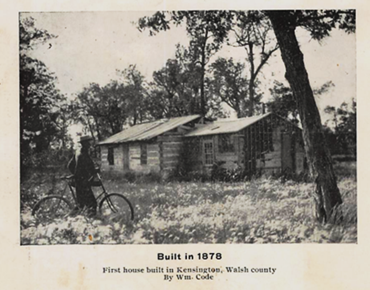
The 1880 census indicated that the family of Abraham Code was living in Drayton, North Dakota. It is likely that they found temporary lodging there while arrangements were made to secure homestead lands and housing in Kensington (later Park River). The family listed was Abraham (age 65) and Letitia (age 64) Code, son, Benjamin Code (age 30), Son William Code (age 35) and his wife Margaret Code (age 28). Also present were the children of William and Margaret Code – Abraham (10), Caroline (8), James (6), William (4) and Letitia (2).
Another son of Abraham and Letitia, Edward Code (age 24), was residing in Grand Forks in 1880 with four young men aged 22 to 28.
John (age 49) and Mary (age 47) Wadge were also residing in Drayton in 1880 with their children – Elizabeth (26), Thomas (24), Susan (16), Archibald (13), Mary (11) and William (4). Susan would become the wife of Edward Code.

Drayton (blue star), Grand Forks (red star) and Park River (Kensington) (yellow star)
The Code families moved into wooded properties along the Park River in Kensington. William and Benjamin also had farms nearby. The Wadge family occupied nearby properties.
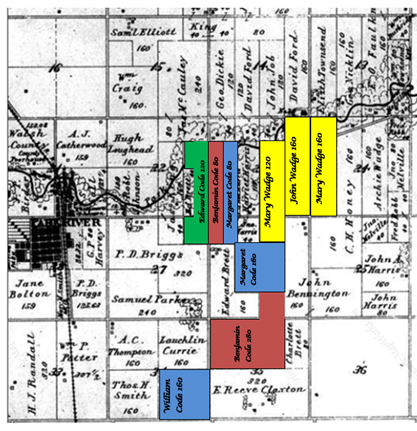
Code family properties near Park River, North Dakota - Margaret was the wife of William Code and Mary was the wife of John Wadge.
The pioneer town was expected to bear the name of Kensington, a post office which had been in existence for many years. Instead it was called Park River . Abraham and many members of his family applied for U.S. Citizenship in the early 1880s. For Abraham and Edward Code Naturalization Petitions were filed on January 9, 1890.
Lettitia died in Park River, North Dakota in 1884 at the age of 68 and Abraham died in 1897 at the age of 82. Abraham had prepared a Last Will and Testament. They were both buried in Park River Memorial Cemetery. William eventually moved to Saskatchewan in Canada and Benjamin to Idaho. Edward and John remained in Park River to raise their families.
Edward Code (1855-1947)¶
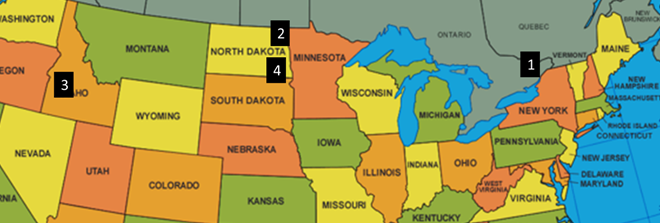
-
Canada, Lanark County, Ontario (1855-1880)
-
North Dakota, Park River (1880-1930)
-
Idaho, Boise (1920-1930)
-
North Dakota, Lisbon (1930-1947)
Edward Code, son of Abraham Code and Lettitia James, was born on 10 Feb 1855 in Lanark County, Ontario, died on 10 Jan 1947 in Lisbon, North Dakota at age 91, and was buried in Park River Memorial Park, Park River, North Dakota. Edward Code Family Photos
Edward married Susan Matilda Wadge on 28 Mar 1883 in Kensington, Dakota Territory, USA. Susan was born on 14 Feb 1865 in Stevens, Ontario, Canada, died on 18 Apr 1904 in Park River, North Dakota at age 39, and was buried in Park River Memorial Park, Park River, North Dakota. They had 3 children. Family of Susan Wadge
Children from this marriage were:
Mary "Minnie" Lettitia Code was born on 26 Nov 1884 in Park River, Dakota Territory, USA, died on 30 Apr 1972 in Santa Barbara, California at age 87, and was buried in Fairmount Cemetery - Denver, Colorado.
Mary married James Theodore Johnson on 27 Nov 1908 in Park River, North Dakota. Theodore was born on Jul 27,1883 in Havana Township, Steele, Minnesota. Wedding
Mary next married Schuyler Stephenson Emens on 17 Jan 1927 in Denver, Colorado. Schuyler was born on 23 Jan 1867 in New York, died in 1938 in Russell, Kansas at age 71, and was buried in Russell City Cemetery - Russell, Kansas.
Mary next married Lawrence L. Sutton in 1942 in Kansas City, Kansas. Lawrence was born on 6 Jan 1881 in Allegheny, Pennsylvania, died on 3 May 1968 in Santa Barbara, California at age 87, and was buried in Fairmount Cemetery - Denver, Colorado.
Milton Edward Code was born on 19 Dec 1886 in Park River, Dakota Territory, USA - died on 21 Jan 1962 in Rock Springs, Wyoming at age 75, and was buried in Oakwood Cemetery - Lisbon, North Dakota.
Milton married Edna Louise Potts, daughter of Charles Edwin Potts and Hannah Greenfield Youhill, on 10 Jun 1908 in Crookston, Minnesota. Edna was born on 22 Apr 1888 in AuSable, Michigan, died on 22 Jan 1962 in Rock Springs, Wyoming at age 73, and was buried in Oakwood Cemetery - Lisbon, North Dakota. They had 8 children.
Fordyce William Code was born on 25 Sep 1888 in Park River, Dakota Territory, USA, died on 25 Oct 1945 in Boise, Idaho at age 57, and was buried in Morris Hill Cemetery, Boise, Idaho. Morris Hill Cemetery
Fordyce married Vivian Clara Schutt on 20 Jul 1925 in Multnomah, Oregon. Vivian was born on 11 Jan 1900 in Oklahoma, died in Jun 1978 in Boise, Idaho at age 78, and was buried in Boise, Idaho. They had 2 children.
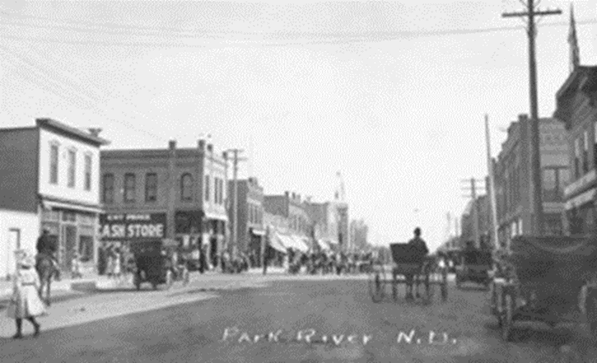
Park River, North Dakota, 1910
Edward Code had helped tend to the family farm in Lanark County, Ontario with his parents until 1872 when he moved to Carlton Place, Ontario to learn the trade of cabinetmaker. There he entered the shop of William Patterson where he served his apprenticeship. He worked in a shop in Brockville, Ontario for four years and came to North Dakota in 1879.
In 1883 Edward Code married Susan Wadge. Susan was the daughter of John and Mary Wadge, close friends and neighbors of the Code family. Members of the Code and Wadge families were active in the Episcopal and Methodist Churches in Park River. A daughter, Mary (Minnie), was born in 1884 and sons Milton and Fordyce were born in 1886 and 1888 respectively. Edward’s mother, Letitia, died in 1884 at the age of 68.
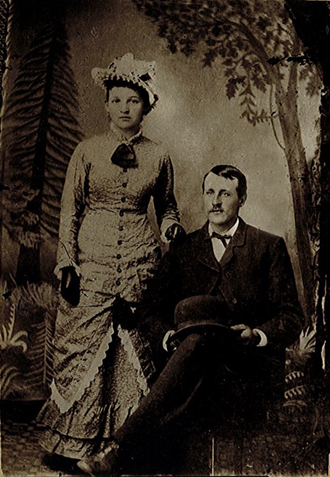
Susan Wadge and Edward Code
A daughter, Mary (Minnie), was born in 1884 - the same year that Edward’s mother, Letitia, died at the age of 68. Sons Milton and Fordyce were born in 1886 and 1888 respectively.

Minnie, Milton and Fordyce Code
The town of Park River was organized in 1884. In that year the Manitoba Railroad was extended from Larimore to Park River. Park River soon became a thriving center of an immense trading territory. During this period there was an interesting story about Edward Code's association with William Rockefeller - father of John D. Rockefeller.
In November 1885, William Code and his associate Paulson, put up a building opposite the Gazette to sell farm equipment.
Park River had its quota of saloons. Two outstanding dispensers were Timley and Jones. Timley’s had a roulette room and a stage at the west end and also served as an opera house. The Jones operation had servers in fancy dress with handlebar mustaches and alligator shoes. The saloons went out of business with the admission of the state into the union in 1889. The drug stores took over the selling of liquor but then only by the permit system. The restrictive system gave birth to alternative ways of obtaining liquor.
In 1896 Thomas Wadge and Thomas Johnson were selling farm Implements – they had purchased the Code and Paulson business. Another Code – William (probably the son of William H.) was a blacksmith in Park River. Edward Code and Joe Irwin had a business selling jewelry and confections.
The elder Abraham Code died in 1998 at the age of 82.

Code & Irwin
Briggs Avenue. Headquarters for stationery, jewelry, fancy goods, fruits, confectionary and cigars
On May 11, 1900 Ed Code purchased the building and lot, 424 Briggs Avenue, occupied by Warner and Peters intending to move his confectionary into it. In 1900 Park River was a thriving, growing prosperous city with a population between 1400 and 1500 and a wide variety of businesses.
On February 28, 1901 a fire wiped out many of the businesses in Park River. With warm temperatures and a 50 to 60 mile an hour wind the fire moved quickly through the buildings sparing few from complete destruction.

Reconstruction soon began with restrictions that all business places were required to use brick for exterior walls. During this period Edward Code and J. B. Taintor erected a building where he operated a confectionary and the new telephone franchise was granted to him. The telephone exchange was in operation in rooms on the second floor of the Code Building. Edward Code had been granted a fifteen-year franchise by the city council to erect and operated a telephone system in the city. Taintor, who had a meat market on the west side of town, moved into the new building. The Code Building is still in use today (2022).
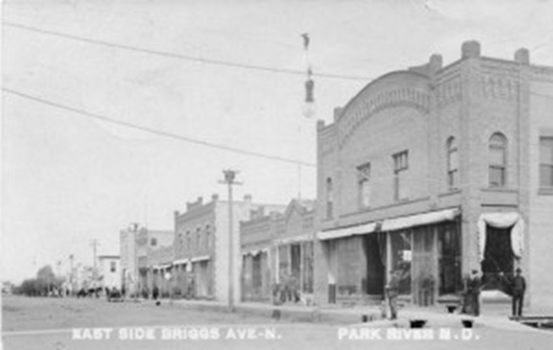
Code Building (tall building far right) - Early 1900s Source
In December of 1903 Ed Code branched out his telephone system along river road east to Kensington Bridge.
Edwards wife, Susan, died suddenly and unexpectedly in 1904 at the age of 39. She suffered a stroke while in the act of preparing the family dinner and never regained consciousness. The funeral for Susan Wadge Code was held at St. Peter's Episcopal Church in Park River.
From 1904 to 1909 Edward Code continued to run his confection and jewelry business and was manager of the opera house in Park River. He was also manager of the Northwestern Telephone Exchange Company for Park River.
Edward’s son, Milton married Edna Louise Potts in June of 1908. Edna’s father, Charles E. Potts, who managed the Atlas lumber Company in Crookston, Minnesota was also managing the Robertson Lumber Company in Park River in 1907. Edward’s daughter, Minnie, married Theodore Johnson in November of 1908. (Minnie was to later marry Schuyler Stephenson Emens on 17 Jan 1927 in Denver, Colorado and Lawrence L. Sutton in 1942 in Kansas City, Kansas)
From 1910 to 1911 Edward was a police magistrate.
The 1910 census indicates that Edward was living in the home of his daughter, Minnie and her husband Theodore Johnson in Park River.
In 1911 Edward moved to Boise, Idaho where his son, Fordyce, and brother, Benjamin, were residing. Edward’s address there was 1019 Ellis. From 1917 through 1925 he resided at 1415 North 13th Street in Boise. Fordyce married Vivian Schutt in 1925. Benjamin Code died in 1929. Edward was in Boise in 1930 but soon thereafter moved in with his son Milton’s family in Lisbon, North Dakota where he lived until his passing in 1947 at the age of 91. While residing in Lisbon, Edward related some of his early Dakota experiences to family members.
Two of the major north-south streets in Park River are Code Avenue and Wadge Avenue.
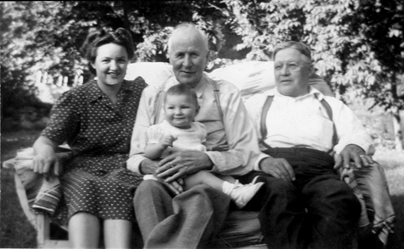
Four Generations: (Left to Right) Granddaughter Betty Lou (Code) Moslet, Edward Code holding great granddaughter Sandy Moslet and son Milton Code
The details in the following paragraph are taken from his 1947 Walsh County Press obituary (from Lew Gaubert's The Code Family):
Park River, N. D. - Funeral Services were held for Edward Code 91, one of the first settlers in this community who died in Lisbon where he had been residing with a son, M. E. Code. Mr. Code was born in Lanark County, Ontario, February 10, 1855 and resided on a farm with his parents until 1872 when he moved to Carlton Place, Ontario to learn the trade of cabinetmaker, entering the shop of William Patterson where he served his apprenticeship. He worked in a shop in Brockville, Ontario for four years and came to North Dakota in 1879.
He took up land near Park River, which was then in Pembina County. On March 28, 1883, he was married at Kensington, North Dakota to Susan M. Wadge and they were parents of three children; Minnie, Milton and Fordyce. The family moved from the farm to Park River in 1895 and Mr. Code went into business with Joe Erwin, purchasing Erwin's interests later. He was the first toll operator here after the Northwestern Bell Telephone Co. established a long-distance line. He later built the first telephone exchange in Park River, operating it until 1909.
His wife died in Park River in 1904. Surviving are a son, M. E. Code of Lisbon and a daughter, Mrs. L. L. Sutton, Santa Barbara, California.
Edward, Susan and several members of the family are buried in the Park River Memorial Cemetery.
PHOTOS: Edward Code
Milton Edward Code (1886-1962)¶
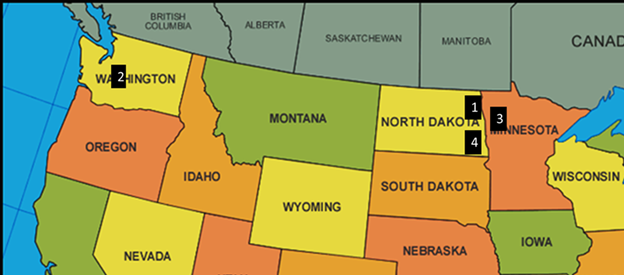
-
North Dakota, Park River (1886-1910)
-
Washington, Toppenish (1910-1915)
-
Minnesota, Crookston (1915-1927)
-
North Dakota, Lisbon (1927-1962)
Milton Edward Code, son of Edward Code and Susan Matilda Wadge, was born on 19 Dec 1886 in Park River, Dakota Territory, USA, died on 21 Jan 1962 in Rock Springs, Wyoming at age 75, and was buried in Oakwood Cemetery - Lisbon, North Dakota. Milton Code
Milton married Edna Louise Potts, daughter of Charles Edwin Potts and Hannah Greenfield Youhill, on 10 Jun 1908 in Crookston, Minnesota. Edna was born on 22 Apr 1888 in Au Sable, Michigan, died on 22 Jan 1962 in Rock Springs, Wyoming at age 73, and was buried in Oakwood Cemetery - Lisbon, North Dakota. They had 8 children.
ADDITIONAL INFORMATION: The parents and siblings of Edna Potts. Family of Edna Potts
Children from this marriage were:
Dorothy Louise Code was born on 7 Jan 1909 in Park River, North Dakota, died on 04 Oct 1995 in Ramsey County, Minnesota at age 86, and was buried in Lakewood Cemetery - Minneapolis, Minnesota.
Dorothy married Cecil John Rhoades, son of Blutcher Wellington Rhoades and Mary Catherine Seibert, on 19 Dec 1930 in Minnesota. Cecil was born on 29 Apr 1902 in Minneapolis, Minnesota, died on 21 Nov 1984 in Minneapolis, Minnesota at age 82, and was buried in Lakewood Cemetery - Minneapolis, Minnesota. They had 1 son and 1 daughter. Dorothy and Cecil Rhoades
Dorothy next married Harold Norman Jacobsen on 18 Dec 1988 in Minneapolis, Minnesota. Harold was born on 21 Jan 1907 in Minnesota, died on 14 Apr 2000 in St. Paul, Minnesota at age 93, and was buried in Saint Mark’s Episcopal Cathedral Columbarium - Minneapolis, Minnesota. They had no children. Dorothy and Harold Jacobsen
Charline Virginia Code was born on 22 Nov 1910 in Crookston, Minnesota, died on 27 Feb 1999 in Dallas, Texas at age 88, and was buried in Evergreen Cemetery, Portland, Maine.
Charline married Alonzo Lewis Gaubert, son of Lewis Ring Gaubert and Ethel Charlena Gaubert, on 19 Oct 1936 in New York, New York. Alonzo was born on 27 Mar 1910 in Livermore Falls, Maine, died on 9 Jan 1984 in Ellsworth, Maine at age 73, and was buried in Evergreen Cemetery, Portland, Maine. They had 2 sons. Charline and Alonzo Gaubert
Edwin Arthur Code was born on 23 Aug 1913 in Toppenish, Washington, died on 12 Sep 2001 in Williston, North Dakota at age 88, and was buried in Petersburg, North Dakota.
Edwin married Wilhelmina Karen Hildre, daughter of Ole Petersen Hildre and Berthine "Tina" Enga Josephine Reiten, on 9 Mar 1946 in Petersburg, North Dakota. Wilhelmina was born on 13 May 1914 in Grand Forks, North Dakota, died on 23 Mar 1989 in Fargo, North Dakota at age 74, and was buried in Petersburg, North Dakota. They had 2 sons and 3 daughters. Edwin and Wilma Code
Eleanor May Code was born on 8 May 1916 in Crookston, Minnesota, died on 27 Mar 2002 in Palm Springs, California at age 82, and was buried in Greenwood Cemetery, Bayfield, Wisconsin.
Eleanor married Glenn Gladstone Gregory Jr., son of Glenn Gladstone Gregory Sr. and Jessica Ann Scott around 1941. They were divorced around 1942. Glenn was born on 12 Aug 1919 in New York and died on 15 Dec 1989 in Houston, Texas. They had no children.
Eleanor next married Craig Burton Ladd, son of Charles Benjamin Ladd and Ann Julia Burton on 12 May 1947 in Minneapolis, Minnesota. Craig was born on 30 May 1919 in Wisconsin, died on 12 Jan 1949 in Rhein Main, Germany at age 29, and was buried in Greenwood Cemetery, Bayfield, Wisconsin. They had no children. Eleanor and Glenn Gregory and Craig Ladd
Charles Milton Code was born on 3 Nov 1917 in Crookston, Minnesota, died on 23 Nov 1999 in Minneapolis, Minnesota at age 82, and was buried in Fort Snelling Cemetery - Minneapolis, Minnesota.
Charles married Marion Nora O'Brien, daughter of Robert O'Brien and Nora Guiney, on 29 Jun 1945 in Minneapolis, Minnesota. Marion was born on 5 Jan 1922 in Baker, Montana, died on 3 Apr 2008 in Chaska, Minnesota at age 86, and was buried in Fort Snelling Cemetery - Minneapolis, Minnesota. They had 3 sons and 2 daughters. Charles and Marion Code
Marjorie Ann Code was born on 22 Mar 1922 in Crookston, Minnesota and died on 4 Jun 2010 in Fargo, North Dakota at age 88.
Marjorie married Arnold Joseph Johnson, son of John W. Johnson and Freda, on 23 Jan 1942 in Moorehead, Minnesota. Arnold was born on 2 Jan 1921 in Lisbon North Dakota and died on 26 Jul 2008 in Lisbon North Dakota at age 87. They had 2 sons and 3 daughters. Marjorie and Arnold Johnson
Betty Lou Code was born on 11 Oct 1923 in Crookston, Minnesota and died 29 Sept 2020 in Chandler, Arizona at age 96.
Betty married Stanley LeRoy Moslet, son of Sivert Pedersen Moslet and Oline Olsdtr, on 1 Nov 1942 in Minneapolis, Minnesota. Stanley was born on 17 Apr 1924 in Luck, Wisconsin and died on 16 Jan 1983 in Billings, Montana at age 58. They had 2 sons and 2 daughters. Betty and Stanley Moslet
Betty next married John Clyde (Jack) Fish, son of Clyde Melford Fish and Clarice Eleanor Halverson, on 9 Oct 1979 in Trenton, Maine. John was born on 18 Dec 1925 in St. Paul, Ramsey, Minnesota and died on 29 Oct 2011 in St. Paul, Minnesota at age 85. They had no children. Betty and Jack Fish
Lois Ann Code was born on 14 Dec 1928 in Lisbon North Dakota.
Lois married Leo Francis Egan, son of William Anthony Egan and Margaret A. Fitzpatrick, on 17 Apr 1948 in St. Paul, Minnesota. Leo was born on 16 May 1925 in Savage, Minnesota and died on 22 Apr 1981 in Minneapolis, Minnesota at age 55. They had 2 sons and 4 daughters. Lois and Leo Egan
Milton Edward Code was born December 19, 1886, the son of Edward and Susan Wadge Code, near Park River in what was then Dakota Territory. An older sister Mary "Minnie" Lettitia Code had been born in 1884. A brother, Fordyce William Code, was born in 1888.
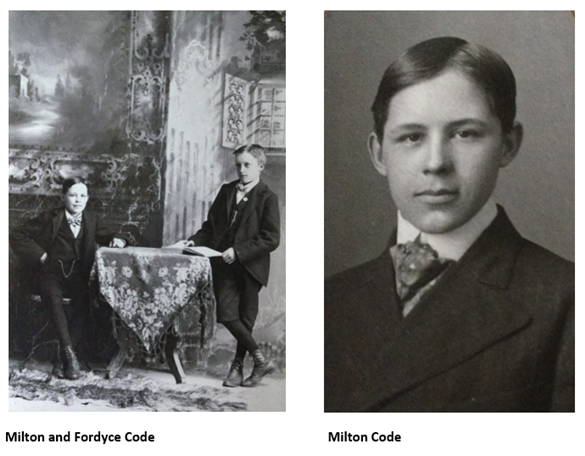
They resided on their farm near Park River until 1895 when the family moved into the town of Park River, North Dakota where Edward Code managed retail stores selling confections and jewelry. Edward also was also responsible for providing telephone services for the community. Their mother, Susan, died in 1904 at the age of 39 when Milton was 18 years old. The children attended school in Park River and Milt and Fordyce played football in high school. In May of 1907 Milton went to Fargo where he accepted a position with Northwestern Telephone Company.
Milt and Edna Louise Potts met in Park River, N.D. Edna’s father who was managing the Atlas Lumber Company in Crookston, Minnesota and also appears to have been managing the Robertson Lumber Company in Park River. On June 10, 1908, Milt and Edna were married in the home of her parents in Crookston, Minnesota. The Reverend Mr. Richard Cox, an Episcopal minister officiated. Edna's sister, Miss Marguerite Potts and Milt's father, Edward Code, were the attendants. After a wedding supper they took the Northern Pacific Flyer to Minneapolis, where they honeymooned at the Nicollet Hotel.
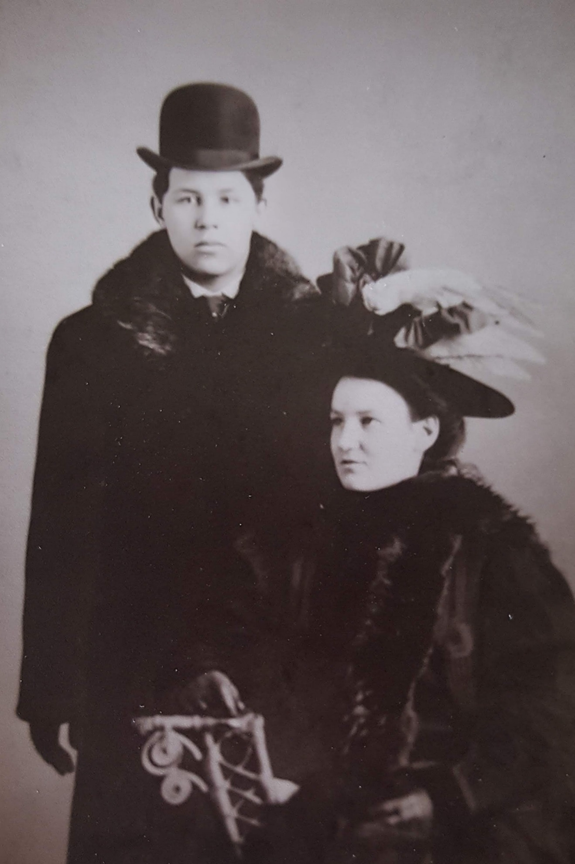
Milton and Edna Potts Code Wedding
Milt’s sister, Minnie, married Theodore Johnson on 27 Nov 1908 in Park River. Around this time Fordyce moved to Boise, Idaho where his uncle Benjamin was residing. From 1908 to 1910 Milton was employed by the Northwestern Telephone Company in the process of providing telephone services for several of the surrounding towns. During that time Edna gave birth to daughters Dorothy in 1909 and Charline in 1910. Around 1911 the family relocated to the Yakima Valley of Washington where he was hired to manage telephone lines and switchboards of the Yakima Valley Telephone Company. A son, Edwin, was born In Toppenish, Washington in 1913.
Milton moved his family from Washington to Crookston, Minnesota in 1915 to help manage the lumber business of his father in law Charles E. Potts. In Crookston a son, Charles, was born in 1917, as were daughters, Eleanor in 1916, Marjorie in 1922 and Betty in 1923. Milton worked with his father-in-law until Charles died in 1925, at which time Milt took over the management of the lumberyard. Ownership of the business had passed to Charles' wife Hannah and over the following year it became clear to Milt that their business relationship could not continue. In early 1927, Milton and Edna moved their family to Lisbon, North Dakota where he was hired to manage the Thompson Lumber Yard. Their daughter, Lois Ann, was born in Lisbon in December of 1927.
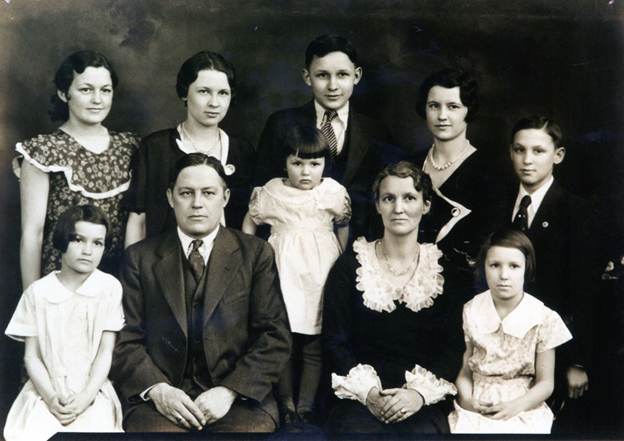
Family photo from around 1930
Front row (left to right): Betty, Milton, Lois, Edna, Marjorie
Back row (left to right): Charline, Dorothy, Edwin, Eleanor, Charles
Their children attended Lisbon High School and the family was very active in the Holy Trinity Episcopal Church. All were baptized and confirmed in the Episcopal Church. After high school Dorothy attended St. Barnabas Hospital School of Nursing and married Cecil John Rhoades on December 19, 1930 in Minneapolis, Minnesota. Charline also graduated from St. Barnabas Hospital School of Nursing in Minneapolis and married Alonzo Lewis Gaubert on October 19, 1936 in New York, New York. Eleanor attended Minneapolis Business College and worked in the Polyclinic in Denver, Colorado. Eleanor married Glenn Gladstone Gregory Jr in 1940 and they were divorced around 1942. Edwin entered the U. S. Navy in December of 1941. He served with the 1st Division of Marines that landed on Guadalcanal and returned to the United States in 1944. He then served as Pharmacist Mate 1-c on the U. S. naval hospital staff in Philadelphia, Pennsylvania. After returning to North Dakota he married Wilhelmina Karen Hildre on March 9, 1946 in Petersburg, North Dakota. Charles Code attended the University of Idaho prior to entering the service in July of 1942. He was a Sergeant in an army air corps repair squadron serving in France and England. Charles married Marion Nora O'Brien on June 29, 1945 in Minneapolis, Minnesota. Marjorie attended Burroughs Business School in Minneapolis and married Arnold Joseph Johnson on January 23, 1942 in Moorehead, Minnesota. After high school Betty Lou married Stanley LeRoy Moslet on November 1, 1942 in Minneapolis, Minnesota. Lois Ann married Leo Francis Egan on April 17, 1948 in St. Paul, Minnesota.
Milton and his sons were Mason’s. Edna was a Worthy Grand Matron of Eastern Star and all their daughters were members of Eastern Star. Edna was selected outstanding Mother of North Dakota in 1945 by the American Mothers Committee of the Golden Rule Foundation.
Milton managed the Lumber Yard through the depression and World War Two. Milton’s father, Edward Code, lived with the family from the early 1930s until his death in 1947. Several members of the family as well as their spouses served during World War II and all returned safely. Son in law, Craig Burton Ladd (second husband of Eleanor Code) died January 12, 1949 when the Air Force cargo plane he was piloting crashed during the Berlin airlift operation.
In 1946 Milton decided to open his own independent lumber yard which he named Lisbon Cash Supply. Several members of the family worked there after returning from service following the war. Sons, Edwin and Charles eventually took over management of the lumber yard as Milton moved toward eventual retirement in 1954. Charles left the business in 1968 when he was named Commandant of the North Dakota State Soldiers Home in Lisbon. The families of Edwin and Charles Code and Marjorie Code Johnson chose to remain in Lisbon to raise their family. Marjorie’s husband, Arnold Johnson managed the Red Owl Grocery store in Lisbon. Milton and Edna were able to share many visits and holiday celebrations with these three families which included fifteen grandchildren. In 1954 the families mourned the loss of Carol and Roger Johnson, children of Arnold and Marjorie Johnson. Carol (aged 8) and Roger (aged 6) drowned in the Sheyenne River in Lisbon on February 21, 1954.
Milton and Edna celebrated their 50th Wedding Anniversary in 1958. The celebration was attended by all their living relatives (fifty-eight in all) as well as many friends from the community.
They enjoyed traveling with friends within the United States often to the west and southwest. Milton Code died as a result of an automobile accident near Rock Springs, Wyoming on January 21, 1962. Edna died from her injuries the following day. They were traveling to California with close friends who were seriously injured but survived the crash. The funeral was held at The Holy Trinity Episcopal Church where members of the Code family had been active throughout their lives in Lisbon. They were buried in Oakwood Cemetery in Lisbon.
Note: Additional family information and photos can be found in the Edna Potts section of the Potts branch of this website.